Introduction
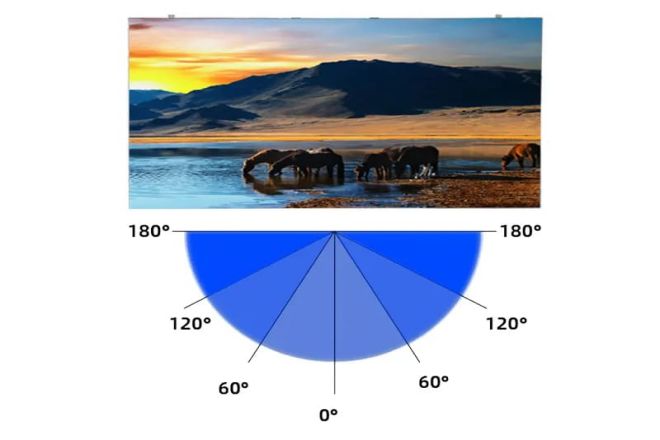
In the center of a bustling square, surrounded by dense crowds, your LED display is trying to attract everyone’s attention. But have you ever noticed that as the audience moves, the color and clarity on the screen seem to change quietly? Behind this is the secret of optimizing the viewing angle of LED displays.
Why do some displays remain clear no matter from which angle you look at them, while others are not? How do you make your LED display stand out and become the focus in a highly competitive market? The answer lies in the techniques of viewing angle optimization.
1. What are the viewing angles of LED display screens?
The viewing angles of LED display screens are not mainly defined by direct classification such as “narrow viewing angle, medium viewing angle, wide viewing angle, and ultra-wide viewing angle,” but are more related to their installation environment, purpose, and specific technical parameters.
However, in response to your classification, I can try to make a general classification of the viewing angle of LED displays based on general understanding and technical parameter ranges:
- Narrow viewing angle LED display:
This type of display has a relatively small viewing angle in the horizontal and vertical directions and is usually suitable for occasions where the viewing range needs to be controlled or side peeping is prevented, such as confidential meetings, bank counters, etc.
However, it should be noted that not all LED displays have clear “narrow viewing angle” products. This classification is more based on an understanding of application scenarios and technical parameters. The viewing angle may be less than 100°.
- Medium viewing angle LED display:
This type of display is between a narrow viewing angle and a wide viewing angle in terms of viewing angle. It is suitable for general commercial displays, indoor activities, and other occasions, and can provide a relatively balanced viewing experience. The viewing angle is approximately between 100° and 140°.
- Wide viewing angle LED display:
This type of display has a large viewing angle and can maintain image clarity and color accuracy over a wide range. It is suitable for large-scale events, outdoor advertising, stadiums, and other occasions that require wide audience coverage. The viewing angle is usually greater than 140°, and some high-end products can even reach 160° or wider.
- Ultra-wide viewing angle LED display (also known as panoramic viewing angle, full viewing angle, etc.):
This type of display pursues the ultimate viewing angle in technology, striving to provide excellent viewing effects at any angle. However, it should be noted that “ultra-wide viewing angle” is not a strict technical standard or classification but a description of products with extremely large viewing angles.
The viewing angle is close to or exceeds 180°, but it should be noted that due to the physical structure and optical characteristics of LED displays, achieving a true 360° full viewing angle is still a technical challenge.
2. How to measure the viewing angle of LED displays
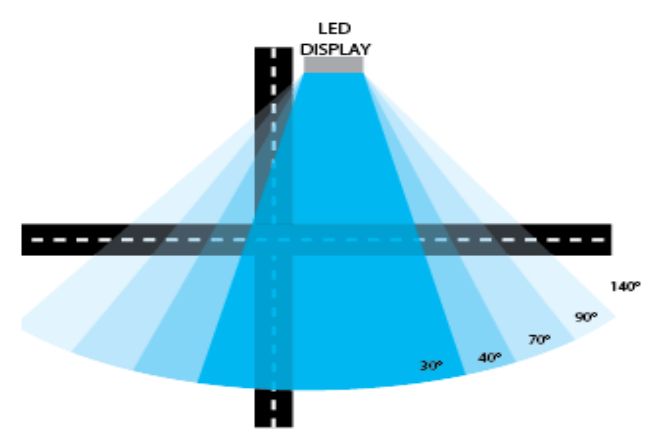
Imagine that you are standing in front of an LED display that is playing some bright images or videos. Now, you want to know from what angle range the display can still remain clear and bright. This is the “viewing angle” we want to measure.
1). Basic steps to measure viewing angle:
- Choose a color:
First, the display will be set to display only one color (such as pure red, pure green, or pure blue), and the brightness will be adjusted to the highest. This is because we want to measure the viewing angle of each color separately.
- Find the center point:
Determine a center point on the display, such as the middle of the screen. This point will be the starting point of our measurement.
- Measure the horizontal viewing angle:
Stand in front of the display and use a tool called a “brightness meter” or “color analyzer” to measure the brightness of the center point.
Then, you slowly move to the left while observing the reading on the brightness meter. When the brightness drops to half of the original, stop and write down the angle between your current position and the center point. This is the horizontal viewing angle to the left.
Next, you return to the center point and move to the right, repeating the above steps to get the horizontal viewing angle to the right.
Finally, the smaller of the two angles is used as the horizontal viewing angle of the display.
- Measure the vertical viewing angle:
This step is very similar to measuring the horizontal viewing angle, but you move up and down instead of left and right. Again, you need to find the position where the brightness drops to half and write down the angle. Measure both up and down, and then take the smaller angle as the vertical viewing angle.
2). Notes:
Ambient light: Try to measure in a darker environment because too bright ambient light may affect the measurement results.
Tool accuracy: The brightness meter or color analyzer used must be accurate and reliable so that accurate measurements can be obtained.
Multiple measurements: To improve accuracy, you can measure several times and then take the average.
3. Analysis of factors affecting the viewing angle of LED display screens
There are many factors that affect the viewing angle of LED display screens, which together determine the viewing effect of the display screen at different angles. The following is a detailed analysis of the four aspects of LED chip characteristics, packaging technology, display module design, and control system and drive:
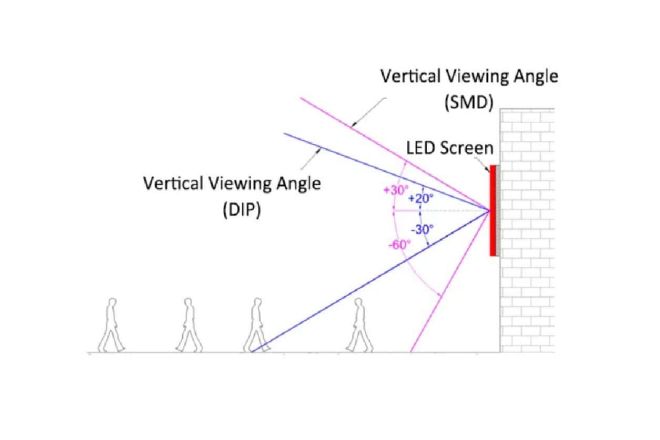
- LED chip characteristics
The viewing angle of the LED chip is one of the important factors that determine the viewing angle of the LED display screen. The viewing angle of the LED chip refers to the angle range of light distribution when the LED emits light.
LED chips with different viewing angles are suitable for different application scenarios. For example, most outdoor display screens use elliptical LEDs with a horizontal viewing angle of 100° and a vertical viewing angle of 50° to ensure that clear images can be seen over a wider range, while indoor display screens may use SMD LEDs with a horizontal and vertical viewing angle of 120° to provide a wider viewing angle.
In addition, the brightness of the LED chip is also a factor that affects the viewing angle because high-brightness LED chips can compensate for the brightness loss caused by the reduction in viewing angle to a certain extent.
- Packaging technology
Packaging technology has a direct impact on the viewing angle of the LED display screen. Different packaging methods will cause the light emitted by the LED chip to scatter at different angles, thereby affecting the viewing angle of the display screen.
For example, LED chips packaged with SMD (surface mount technology) usually have a wider viewing angle because they can more effectively control the scattering direction of light. In addition, the light transmittance and heat dissipation performance of the packaging material will also affect the viewing angle and overall performance of the LED display.
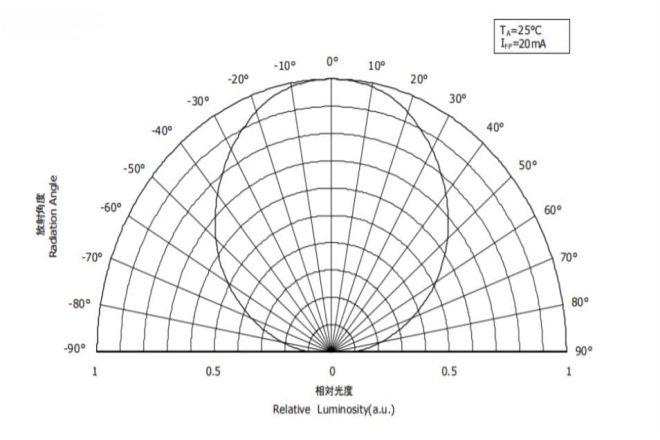
- Display module design
The design of the display module is also one of the key factors affecting the viewing angle of the LED display. The arrangement and spacing of the LED lamp beads in the module and the splicing method between modules will affect the viewing angle of the display.
Reasonable arrangement and spacing of the lamp beads can ensure that the light is evenly distributed at different angles and improve the viewing angle of the display.
At the same time, the splicing accuracy between modules will also affect the overall viewing angle of the display. If the splicing is uneven or there are gaps, it may cause light to scatter or reflect in these areas, thereby reducing the viewing angle of the display.
- Control system and drive
Although the control system and drive do not directly determine the viewing angle of the LED display, they have an important impact on the display effect and stability of the display and indirectly affect the audience’s viewing experience.
The control system is responsible for receiving external signals and converting them into instructions that the drive circuit can understand to control the brightness, color, and other parameters of the LED display. High-quality control systems and drive circuits can ensure that the display screen can maintain stable display effects and color reproduction at different angles.
In addition, the control system can also balance the relationship between viewing angle and brightness by adjusting the brightness of the LED chip to achieve the best viewing effect.
4. Steps to optimize the viewing angle of the LED display
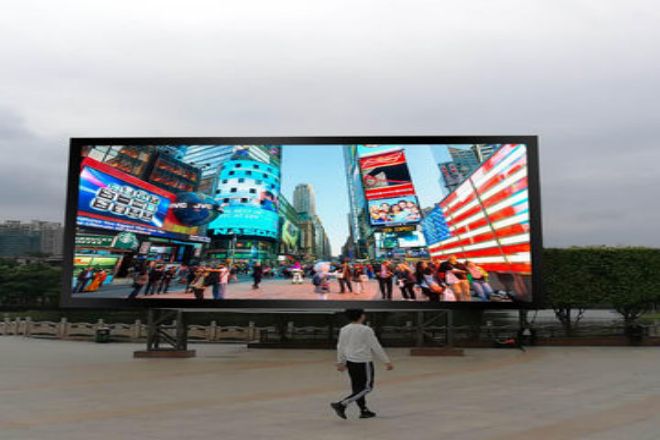
The steps to optimize the viewing angle of the LED display are a comprehensive process involving adjustments and improvements in many aspects.
1). Optimize LED chips and packaging.
Choose high-viewing angle LED chips: According to actual needs, select LED chips with wider viewing angles, such as chips with horizontal and vertical angles of 120° or more.
Improve packaging technology: Use advanced packaging technology, such as lens packaging, to improve the light scattering direction of the LED chip and increase the viewing angle.
2). Adjust the display module design.
Optimize the arrangement of lamp beads: Adjust the arrangement of LED lamp beads in the module to make the light distribution more uniform and improve the consistency of the viewing angle.
Reduce the distance between lamp beads: Without affecting heat dissipation and cost, appropriately reduce the distance between lamp beads to increase the pixel density per unit area, thereby improving the viewing angle effect.
Improve module splicing: Ensure the flatness and precision of the splicing between modules to avoid light scattering and reflection problems caused by uneven splicing.
3). Adjust the control system and drive.
Optimize the drive circuit: According to the actual needs and characteristics of the display screen, adjust the parameters of the drive circuit to ensure that the LED chip can obtain stable current and voltage supply at different angles.
Upgrade the control system: Use advanced control systems to improve the transmission speed and stability of signals and reduce the viewing angle loss caused by signal transmission problems.
4). Apply viewing angle optimization technology.
Use viewing angle optimization film:
Attach the viewing angle optimization film to the surface of the display screen to improve the viewing angle and color consistency of the display screen by changing the propagation path and distribution characteristics of light.
The viewing angle optimization film can achieve uniform viewing angle distribution of LED lights of different colors and eliminate the left and right viewing angle differences and the viewing angle differences between different pixels.
Adjust the display content:
According to the characteristics and viewing angle of the display screen, adjust the brightness, contrast, color, and other parameters of the display content to obtain better visual effects.
Conclusion
Through the discussion in this article, it is not difficult to find that the viewing angle optimization of LED display screens is a comprehensive subject involving multiple levels such as technology, design, and application. It is not only about hardware upgrades and renovations, but also about a deep understanding and precise grasp of application scenarios.
Finally, if you want to know more about LED displays, please get in touch with us.
